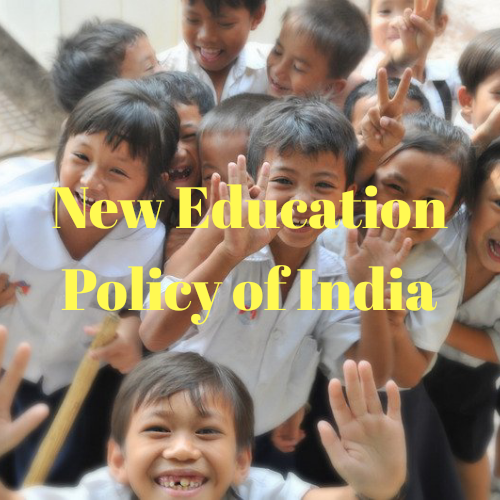The revival of the Indian Education System

Amid the corona pandemic, one sanguine thing that has happened is the revival of the Indian education system. The Modi government has approved a new education policy.
This transformational reform has happened after 34 years of the first education policy that was proposed in 1986. This education policy was amended in 1992 with trivial changes. And after a long gap, the Indian government has come up with a gazillion modification in Education policy.
The main objective of the New Education Policy is to make the Indian education system more propitious and practical for students. The government of India declared to spent 6% of GDP on education. It has also changed the name of the Ministry of Human Resource Development to the Ministry of Education.
The first education policy was introduced in 1968 by Indira Gandhi under the recommendations of the Kothari Commission (1964-66). This was called Radical Restructuring and proposed equal educational opportunities. In this commission, it was estimated that 6% of GDP would be spent on education but India never attained this aim.
Imperative Points of this New Education Policy
There are numerous changes mentioned in the proposal of the Ministry of Human Resource Development. This provision is for school and higher education. MHRD ministry recommended tremendous changes in school education.
India is still following British rule education. School education has been focusing more on class X and class XII. Students entire career depends on these two class. But in this revamping proposal now school education is divided into 5+3+3+4 format.
Let’s look into the 5+3+3+4 school education system. In this system, there are 4 stages: Foundation stage, Preparatory stage, Middle stage, and Secondary stage.
Foundation Stage:
Foundation Stage is a 5-year program which is further divided into 2 stages i.e starting three years are assigned for pre-primary school and rest two years is assigned for class I and II.
This is the Foundation stage it means in this state students will learn in their mother-tongue. In this stage, the main focus will be on making students understandable up to the age of 8 years.
Preparatory Stage:
The preparatory stage is the next stage which is 3 years program. In this stage, students will get an education from class III to V.
Middle Stage :
This stage is also a 3-year program. It includes education from class VI to VIII. In this stage, students will learn coding so that they will get updated to recent technology.
Secondary Stage:
The secondary Stage is an imperative stage in this new education system because students future depends on this stage. MHRD ministry recommended colossal changes in this stage.
Till now this stage focuses on boards and bifurcate students on the basis of subjects they choose after class X.
There is one fascinating point that is quite interesting is that besides their streams students can also study any subject if they want. Like you are a science stream student but you have an interest in business studies or any art subject so you can also study any subject besides your stream subjects.
One can choose biology with accounts or arts with maths irrespective of their stream. There is also one imperative point is that makes students ecstatic. In this new education policy if a student is not good at any subject then they can choose the basic or medium level of that subject.
Like if you are not good at higher levels of maths you can choose a medium level of it. In the new education policy, board examination will continue but its weightage will Plummet.
This is marvelous news for students as it will reduce the mental stress of board exams. In this education policy, all subjects like science, art, commerce all streams will treat at the same level.
Revamping of Higher Education:
New Education Policy also emerges many modifications in higher education. Ministry of Human Resource and Development proposed numerous changes in higher education that will be lucrative for students.
1. As like Neet in medical studies, the MHRD ministry proposed a Common Entrance Exam
( CEE). In impending years this will be the only exam conduct for admission to the university of India.
2. CEE will consist of two papers, one paper has a common aptitude test while the other paper consists of a specialized paper related to a particular stream.
3. CEE will hold twice a year.
4. All educational institutes except medical and legal institutions will be controlled and governed by the Higher Education of India.
5. MHRD ministry recommended abolishing the affiliation system in colleges. In India, a tremendous number of colleges are affiliated to a state university, state technical university.
By this New Education Policy, a State-wise mechanism will establish to grant graded autonomy to colleges.
6. Multidisciplinary universities and colleges will open in a country where students get an education in every stream of education. MHRD ministry wants to achieve this aim by 2040.
7. In every district, at least one university will open.
8. In institutions medium of instruction or program will provide in local or Indian language.
9. The government will establish the National Research Foundation to impetus the research work in Indian institutes.
10. All undergraduate program year increase to 4 years.
11. One most sanguine and fantastic reform is Multiple Exit Options.
Multiple Exit Option:
It is an astonishing change for those students who leave college due to financial or some personal problems. Till now if any student leaves college in the middle year of course their degree is not awarded.
But in the new education policy if a student leaves the study before completion it will not be considered void. Institutes will provide multiple entries and exit options to students. If any student leave after 1 year of study they will be awarded a certificate.
After 2 years students will be awarded Advanced Diploma, after 3 years they will be awarded Bachelor’s Degree and after 4 years i.e completion of degree students will be awarded Bachelor’s Degree with Research.
You all have watched Main hu na movie. Do you remember Shahrukh khan’s role in this movie in which he resumed college after 10 years? Now that concept going to be real. Isn’t it fascinating? This concept is known as the Academic Bank of Credit.
Academic Bank of Credit
Academic Bank of credit means academic credits of students will restore and transferred towards the final degree earned. In simple words students, credit earned during the course will be stored and if due to any problem students leave college in the middle of the course then this credit score will further add towards the completion of the degree.
I think this will be a great decision. Gazillion number of students will get benefit from this. A survey report stated that more than 60% of students leave their college due to poverty. It will be great news for those students.
Vocational Training
Vocational Training will provide to students from class 6 to 8. In this training, students will get opportunities to learn new things besides their studies. MHRD ministry proposed to teach coding in the middle school stage.
Today, in the era of technology it is important to learn coding techniques. This change will make students learn coding from the basic stage.
Education for Specially-Abled Students
Till now there is no provision for specially-abled students in India. Specially-abled students can not take admission to normal school they can only get admission to a special school. In Education Policy MHRD ministry proposed the idea to start sign language courses in school so that specially-abled students can study with normal students.
Digital Learning and Digital Library
In this pandemic, one thing that connects students with their studies is digital learning. Due to coronavirus where all institutions and schools are closed. In this time digital platforms have shown the path to connect students with schools and colleges. Therefore, digital is an indispensable part of learning.
MHRD ministry proposed an idea to start digital learning in schools and institutions. For this purpose government has started several platforms like SWAYAM, MOOCs, NPTEL. The government also going to start a digital library where students will get all materials related to their studies.
Abolishment of M.Phil
This is great news for those students who wanted to do a Ph.d. Now they can directly do a Ph.D. after their master’s degree need not do M.Phil. MHRD ministry proposed to abolish this course from the curriculum.
National Professional Standards for Teachers
TET i.e teacher eligibility test will be held to check teachers’ eligibility and critical knowledge. National curricular framework for teacher education i.e NCFTE will be formulated.
This framework will be created by NCTE i.e National council for teacher education with the deliberation of the National Council of Educational Research and Training. Demo interview tests will be taken after qualifying in the TET exam to check how teachers will teach in class.

Is this New education Policy profitable for students?
Yes, it indeed is advantageous for students. These changes will take the Indian education system to sky-scraping positions.
Since British time we have been carrying burdensome education systems. That time Britishers made this education system to colony Indian society. But it’s a travesty of an Indian education system that we are still following that system.
After a long span of time, the Indian government has taken this step to revive the education system. This education system entails several changes that will be profitable for students.
Let’s look into the optimistic impact of New Education Policy.
1. In the new education policy government, the MHRD ministry proposed the medium of education in primary or fundamental education.
It means up to class 5th the medium of education should be in mother tongue or local language. This will be indispensable for both public and private colleges.
2. MHRD ministry proposed multilingual languages for students. Students will get an opportunity to learn multiple languages.
3. Board weightage will disparage I think this is the most craving modification in the education system.
4. New education policy gives students the power to control their careers according to their choices.
5. Students will be able to learn coding from class 6th itself. With everything going online and all these technology changes, this is the most important and advantageous step for them.
6. Multiple exits is also a marvelous concept. Students can resume their studies after a gap and they will be awarded a degree according to a year of study.
7. There will be a Common exam for entrance in any university and course. This will remove the burden of students. Students can focus on one exam and get the best institutes according to their rank rather than preparing for 10 different exams with the different syllabus.
8. NCC will be incorporated in schools and colleges. It will mandatory for all students.
By and large, we can say that it is really a bundle of revamping. This New Education Policy will definitely change the education system of India. MHRD ministry proposed that this New Education Policy would come into action by 2040.
Some proposals will come into action immediately like the name of the ministry of human resource development into the Ministry of Education.
This is the best step towards making India Educationally independent. This new reform will make students become masters rather than servants.



0 Comments